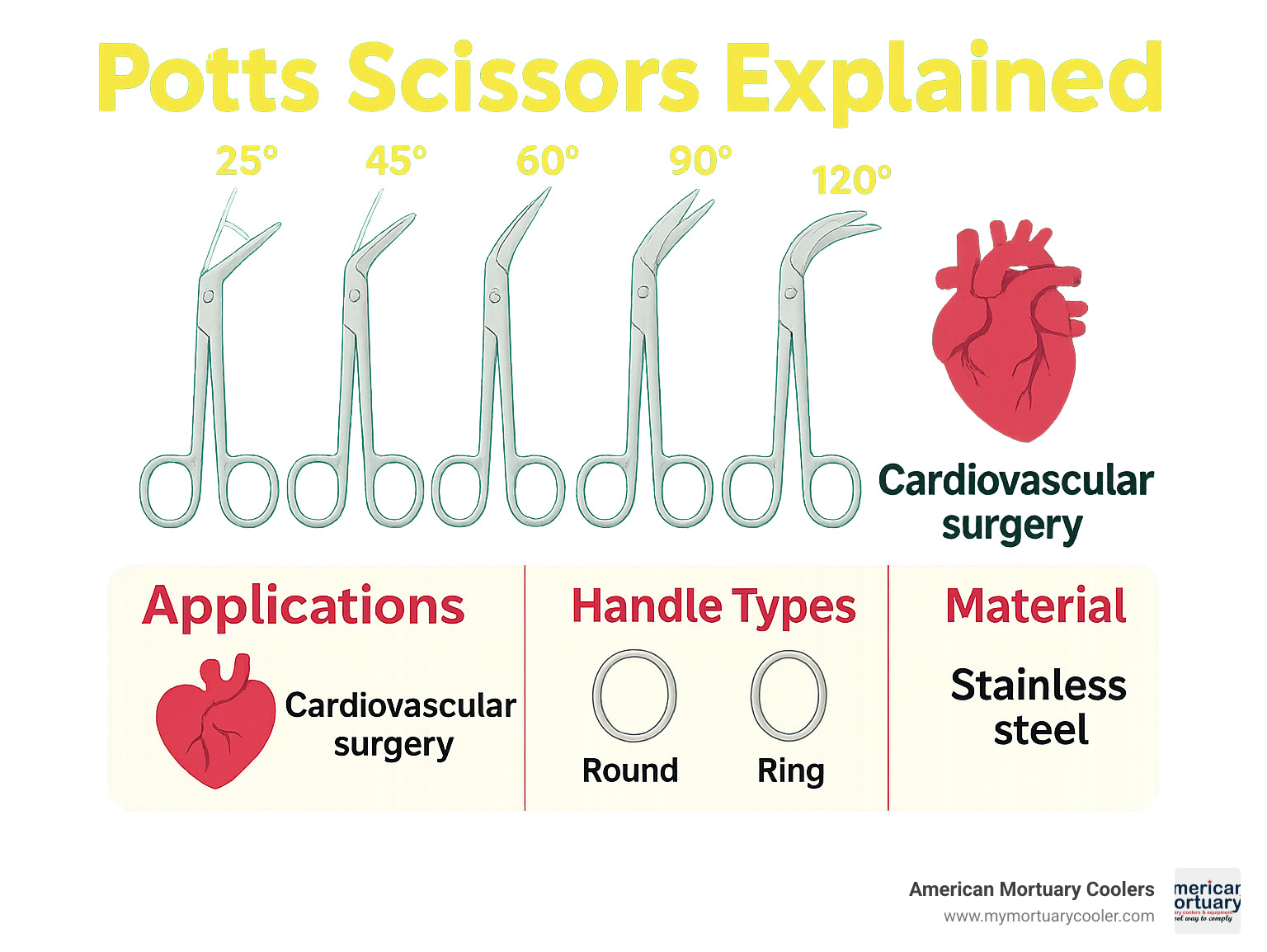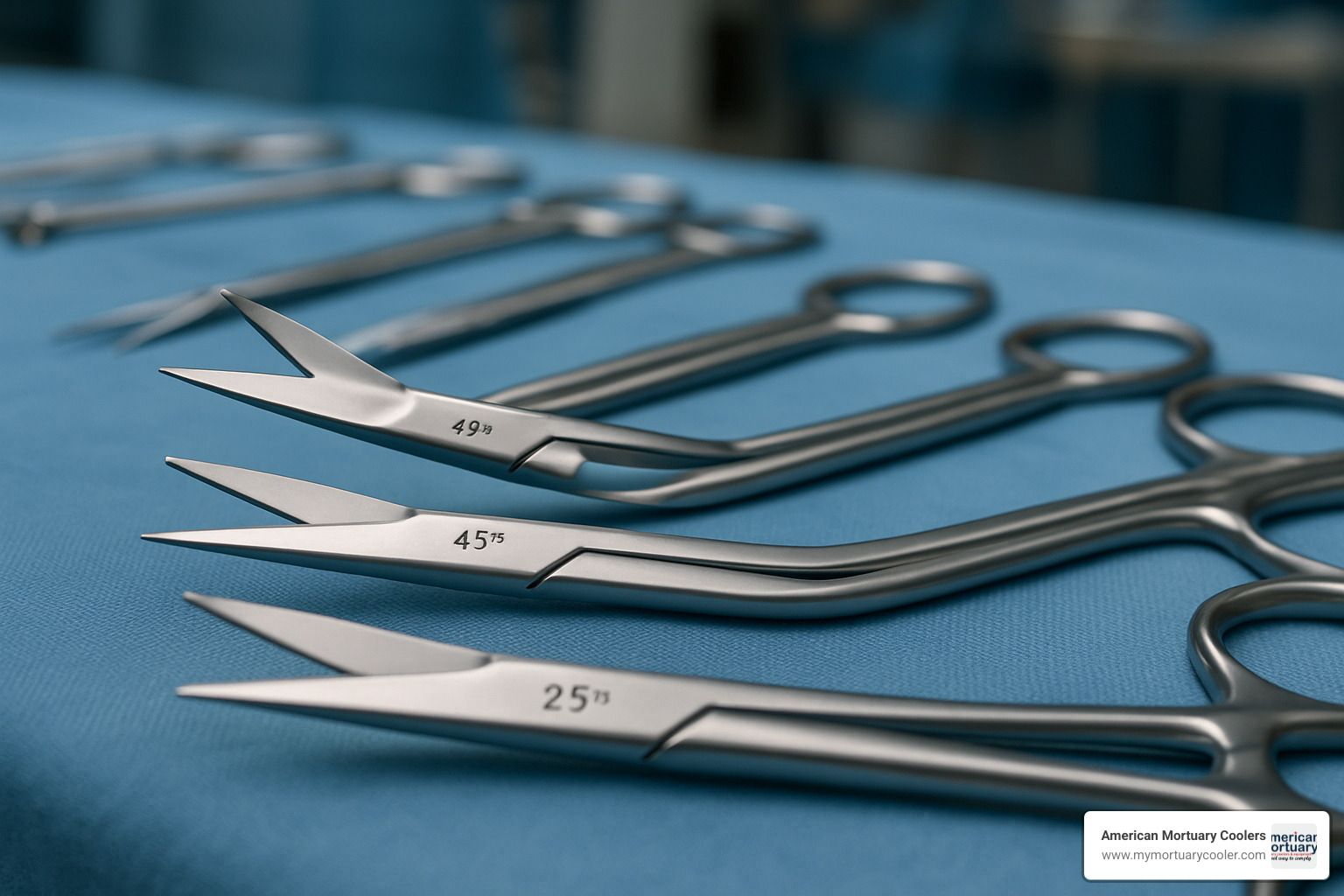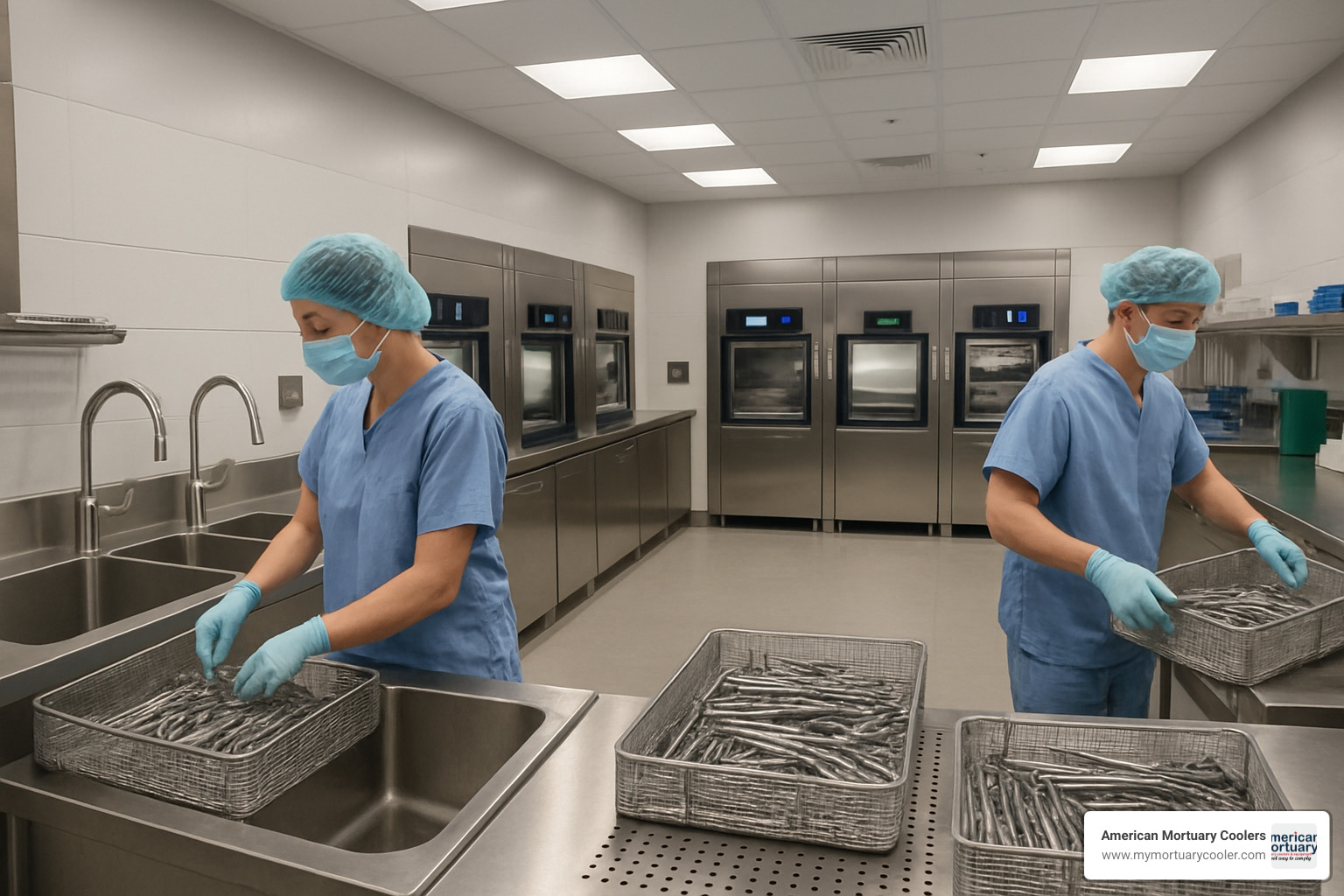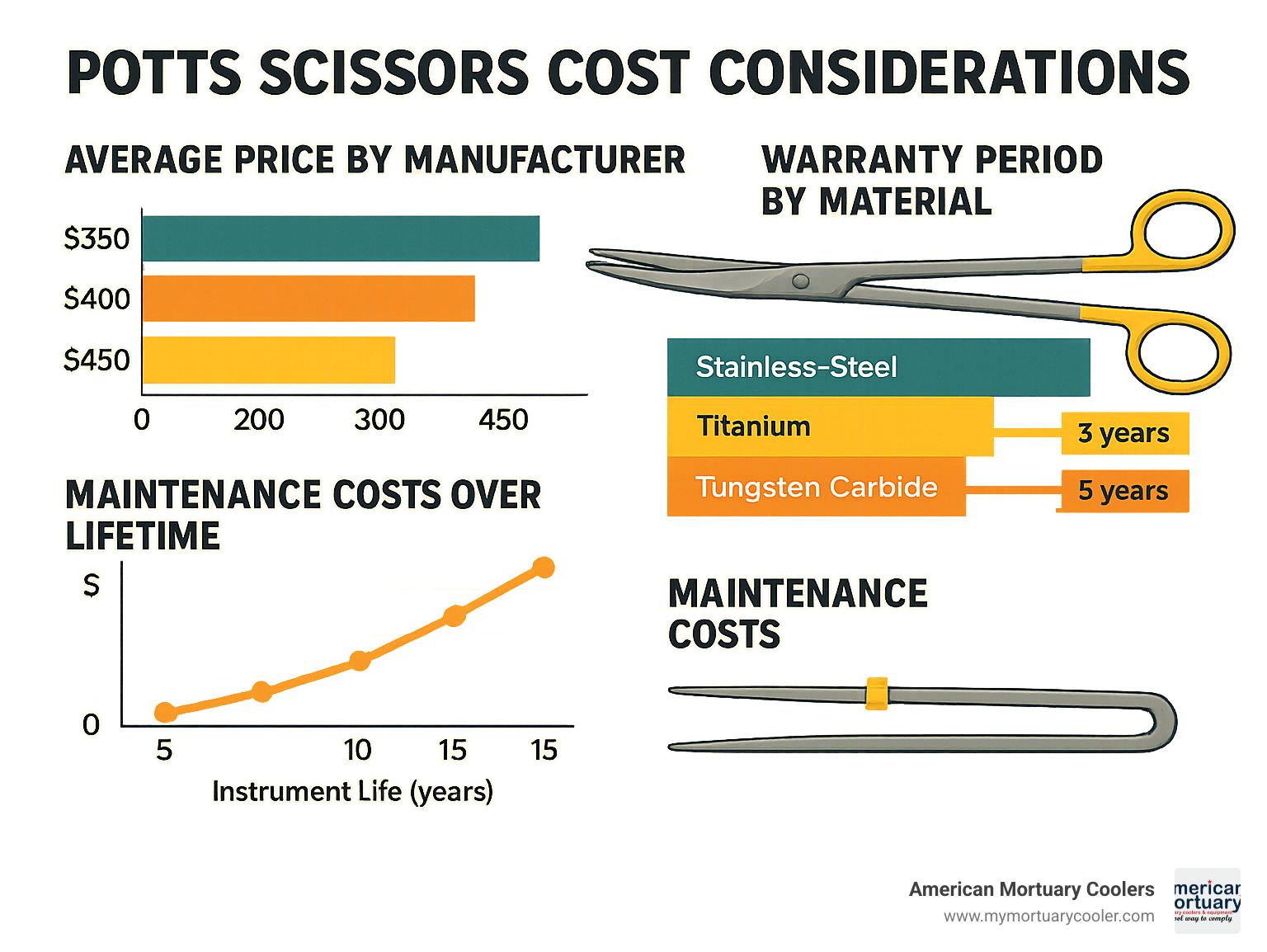Understanding Potts Scissors: The Precision Tool for Vascular Surgery
Potts scissors are specialized surgical instruments designed for precise vascular cutting and arteriotomy procedures in cardiovascular surgery. These angled scissors feature narrow, thin blades and ergonomic handles that allow surgeons to make controlled incisions in blood vessels and delicate tissues.
Key Features of Potts Scissors:
- Blade angles: Available in 25°, 45°, 60°, 65°, 90°, and 120° configurations
- Length: Typically 18-19 cm (7-7.5 inches) overall
- Handle types: Round spring handles or ring handles for precise control
- Materials: High-quality stainless steel construction
- Applications: Cardiovascular surgery, vascular grafting, and microsurgical procedures
- Price range: $50-$862 depending on manufacturer and specifications
These instruments get their name from their primary function in vascular surgery, where surgeons need angled visibility and precise cutting control when working around arteries and veins. The angled blade design improves the surgeon's line of sight while minimizing tissue trauma during delicate procedures.
Modern surgical teams rely on Potts scissors in cardiothoracic units, transplant centers, and endovascular laboratories where precision cutting can mean the difference between successful outcomes and complications.
As Mortuary Cooler from American Mortuary Coolers, I've worked extensively with funeral homes that require precision instruments for various procedures, and I understand how critical proper tool selection becomes when accuracy matters most. My experience with mortuary equipment has taught me that the same principles of precision and reliability that apply to Potts scissors are essential across all professional-grade instruments.

Potts scissors terms explained:
What Are Potts Scissors?
When you step into a cardiovascular operating room, you'll find surgeons reaching for Potts scissors whenever they need to make precise cuts in blood vessels. These aren't your typical surgical scissors - they're specialized instruments built specifically for the demanding world of vascular surgery.
Potts scissors get their name from their starring role in arteriotomy procedures, where surgeons create controlled incisions in arteries. Think of them as the precision artists of the surgical world, designed with narrow, thin blades and angled tips that give surgeons the kind of control they need when working around delicate blood vessels.
The story behind these scissors is pretty straightforward - they evolved from the need for better tools in cardiovascular surgery. Dr. Cary Potts didn't actually invent them (that's a common misconception), but the naming reflects their specialized purpose in the procedures he pioneered. What makes them special is their engineering: every angle, every curve, and every millimeter of blade length serves a specific purpose in vascular work.
Unlike regular surgical scissors that might work fine for general cutting, Potts scissors feature design elements that make them ideal for working in tight spaces around blood vessels. Their narrow profile means less tissue displacement, while their angled blades provide better visibility in deep surgical sites.
Potts Scissors Key Functions
The magic of Potts scissors lies in three main areas where they truly shine.
Vascular incision work represents their bread and butter. When a surgeon needs to make that first critical cut into an artery, Potts scissors provide the controlled precision that can make or break the procedure. The angled blade design isn't just for show - it allows surgeons to approach vessels at the perfect angle while keeping a clear view of what they're doing.
Graft enlargement procedures showcase another strength of these instruments. During complex vascular grafting, surgeons often need to carefully enlarge existing incisions to accommodate new grafts or create proper anastomoses. The controlled cutting action of Potts scissors lets them expand these openings without causing unnecessary trauma to surrounding tissues.
Microsurgery applications have become increasingly important as surgical techniques advance. The fine-tipped design of Potts scissors makes them valuable partners in microsurgical procedures where even the smallest mistake can have major consequences. Their narrow blade profile allows surgeons to work in extremely confined spaces with confidence.
Potts Scissors in Modern OR
Today's surgical teams consider Potts scissors essential equipment across multiple specialties, and you'll find them in some pretty impressive places.
Cardiothoracic teams rely on these scissors daily in cardiac surgery suites. Whether it's a coronary artery bypass procedure, valve repair, or other complex cardiac intervention, Potts scissors provide the precision that these life-saving procedures demand. The surgeons I've spoken with describe them as extensions of their hands during these critical moments.
Transplant units represent another area where Potts scissors prove their worth. Organ transplant procedures require incredibly precise vascular connections between donor and recipient vessels. The success of these procedures often depends on the quality of these connections, making Potts scissors invaluable tools for creating and modifying anastomoses.
Endovascular labs might seem like they'd have less need for traditional cutting instruments given their focus on minimally invasive procedures, but Potts scissors still play important roles. Even in our age of advanced catheter-based techniques, there are moments when precise cutting instruments become essential for achieving optimal outcomes.
Anatomy & Design Features of Potts Scissors
When you first hold a pair of Potts scissors, you'll immediately notice how different they feel from regular surgical scissors. These instruments are precision-engineered tools where every design element serves a specific purpose in vascular surgery.
The most striking feature is the angled blade design. Potts scissors come in six different angles: 25°, 45°, 60°, 65°, 90°, and 120°. Think of these angles like having different camera angles for a movie scene - each one gives the surgeon a unique perspective and access to different areas during surgery.
The 45° and 60° angles are the workhorses of most operating rooms. The 45° version handles most general vascular work beautifully, while the 60° angle shines when surgeons need to reach deeper into chest cavities or around curved blood vessels.
Blade lengths typically measure between 7-13mm, with the entire instrument spanning 18-19 cm (about 7.5 inches). This sizing isn't random - it's the sweet spot that gives surgeons enough leverage without sacrificing the delicate control needed for precision work.
You'll find Potts scissors with two main handle types. Round spring handles provide that continuous, gentle pressure that's perfect for sustained cutting work. Ring handles offer the familiar feel that most surgeons learned with during training. Both work excellently, and the choice often comes down to personal preference and the specific procedure.
| Blade Angle | Primary Applications | Typical Procedures |
|---|---|---|
| 25° | Surface vessel work | Superficial arteriotomies |
| 45° | General vascular surgery | Coronary bypass, peripheral grafts |
| 60° | Deep cavity access | Thoracic procedures |
| 90° | Right-angle approaches | Posterior vessel access |
| 120° | Extreme angle requirements | Complex reconstructions |
The probe tip design varies between models. Some feature fine tips for ultra-precise work, while others have slightly broader tips for more robust cutting tasks. The narrow profile of all Potts scissors allows surgeons to work in incredibly tight spaces around delicate blood vessels.
How Angled Blades Improve Visibility
Here's where the magic of Potts scissors really shows. Imagine trying to cut something in a deep box with straight scissors - your hand blocks your view, right? That's exactly the problem these angled blades solve.
The angled design lets surgeons keep their hands in comfortable positions while directing the cutting action exactly where it needs to go. This means better line of sight into surgical sites and less tissue trauma because there's no need to pull tissues apart just to see what you're doing.
When working in deep cavities like the chest or around curved blood vessels, straight scissors would force surgeons into awkward positions. The angled blades of Potts scissors eliminate this problem entirely, allowing for smooth, controlled cuts even in challenging anatomical locations.
Material Science Behind Durability
Modern Potts scissors are marvels of metallurgy. Most are crafted from German stainless steel, which provides exceptional durability and maintains its sharp edge through countless procedures.
Tungsten carbide inserts in premium models offer even longer-lasting sharpness. Some manufacturers add titanium coatings that reduce friction during cutting while providing additional corrosion protection.
The sterilization compatibility is crucial in today's operating rooms. These scissors must withstand hundreds of autoclave cycles without losing their precision or developing corrosion. The high-quality materials ensure they'll perform consistently whether it's their first use or their thousandth.
Corrosion resistance isn't just about longevity - it's about patient safety. The medical-grade materials used in Potts scissors ensure they remain sterile and safe through repeated cleaning and sterilization cycles.
Surgical Specialties & Procedural Applications
Potts scissors have become trusted companions across multiple surgical specialties, each taking advantage of these precision instruments in their own unique ways. It's fascinating how one tool can adapt to so many different medical needs.
Cardiothoracic surgery remains the primary home for Potts scissors. Heart surgeons rely on these instruments daily for coronary artery bypass grafting, valve repairs, and complex cardiac reconstructions. When you're working around someone's heart, there's simply no room for error - and that's exactly where Potts scissors shine brightest.
Vascular grafting procedures represent another major application area. Peripheral vascular surgeons depend on these scissors for creating and modifying graft anastomoses with surgical precision. The controlled cutting action helps ensure proper graft sizing and positioning, which can make all the difference in patient outcomes.
Pediatric heart surgery presents unique challenges that Potts scissors handle beautifully. Children's hearts are incredibly small and delicate, demanding exceptional precision from every instrument used. The micro-fine blade options available in Potts scissors make them particularly valuable for pediatric cardiac surgeons who work in such tiny spaces.
Neurovascular bypass procedures push precision requirements to their absolute limits. Brain surgery involving vascular bypasses requires instruments that can work in extremely confined spaces while causing minimal tissue trauma. Potts scissors meet these demanding requirements with their angled designs and ultra-sharp cutting edges.
Transplant anastomosis work represents perhaps the most critical application for these instruments. When connecting donor and recipient vessels during organ transplants, surgeons need perfect anastomoses - and Potts scissors help make those life-saving connections possible.
Urology microsurgery has also acceptd these versatile tools. Urological procedures involving small vessels benefit tremendously from the precision cutting capabilities that Potts scissors provide, especially when working with delicate reproductive or urinary tract vessels.
For surgeons seeking detailed technical guidance, Scientific research on arteriotomy techniques provides comprehensive information about proper instrument use and procedural best practices.
Step-by-Step: Using Potts Scissors for Arteriotomy
Mastering Potts scissors technique requires understanding the proper sequence of steps that experienced surgeons follow for successful arteriotomies.
Incision planning starts everything off right. The surgeon carefully identifies the optimal location and angle for the arteriotomy, taking into account vessel size, surrounding anatomy, and the specific requirements of the intended procedure. This planning phase is crucial - rushing here can create problems later.
Blade entry requires steady hands and clear thinking. The angled tip of the Potts scissors gets positioned at the predetermined entry point, with the blade angle specifically chosen to provide optimal visibility and control throughout the procedure.
Cut extension demands smooth, controlled movements. Using steady pressure, the surgeon extends the incision to the required length while maintaining consistent hand position. This ensures smooth, clean cuts that heal properly and don't create unnecessary complications.
Hemostasis wraps up the cutting phase. After completing the arteriotomy, surgeons employ appropriate hemostatic measures while keeping the Potts scissors ready for any necessary incision modifications that might be needed.

Variations, Alternatives, and Leading Brands
The Potts scissors market offers numerous variations designed to meet specific surgical requirements and surgeon preferences.
Primary Variants:
- Potts-Smith Scissors: These feature longer shanks and are often preferred for deeper surgical access
- Potts-DeBakey Scissors: Designed with blunt tips for atraumatic tissue handling
- Delicate Angled Scissors: Feature micro-fine blades for extremely precise work
- Probe-Tip Variants: Include a probe tip for atraumatic tissue exploration
Leading Manufacturers:
- Surtex: Offers customizable configurations with multiple blade angles and optional probe tips
- V-Mueller: Known for high-quality German stainless steel construction
- GerMedUSA: Provides premium instruments with titanium coatings
- ASSI: Specializes in microsurgical variants with ultra-fine tips
Price Range: Our research indicates Potts scissors range from $50.40 for basic models to $862.00 for premium variants with specialized features. Factors influencing cost include:
- Material quality and construction
- Brand reputation and warranty coverage
- Specialized features like probe tips or micro-fine blades
- Manufacturing origin and quality certifications
Warranty Details: Premium manufacturers typically offer:
- Tungsten carbide scissors: 5+ years warranty
- Titanium instruments: 3+ years warranty
- Standard stainless steel: 1 year warranty
Potts Scissors vs Other Vascular Scissors
Understanding how Potts scissors compare to other vascular cutting instruments helps surgeons make informed equipment choices:
Metzenbaum Scissors: While excellent for general tissue dissection, Metzenbaum scissors lack the angled blade design that makes Potts scissors superior for vascular work.
Mayo Scissors: These heavy-duty scissors are designed for cutting sutures and heavy tissues but lack the precision required for delicate vascular procedures.
DeBakey Scissors: Similar to Potts scissors but typically feature different tip designs and may lack the specific angle options available in Potts variants.
Satinsky Scissors: These curved scissors are designed for specific vascular applications but don't offer the angle variety of Potts scissors.
Cutting Edge Geometry: Potts scissors feature beveled blades that "ensure clean dissection planes with minimal effort," setting them apart from conventional scissors designs.
Handle Ergonomics: The round spring handle design of many Potts scissors provides superior control compared to traditional ring handles, particularly during extended procedures.
For additional information about precision surgical instruments, see More info about Metz Scissors.
Selecting the Right Variant for Your Practice
Choosing the appropriate Potts scissors requires consideration of several factors:
Patient Age: Pediatric procedures may require micro-fine blade variants, while adult procedures can accommodate standard blade sizes.
Vessel Size: Larger vessels may benefit from scissors with longer blades, while small vessels require micro-fine precision.
Surgical Approach: The anatomical approach determines the optimal blade angle - deeper procedures may require more acute angles.
Surgeon Preference: Individual surgeon technique and training influence handle type and blade angle preferences.
Buying Guide: Cost, Care, and Longevity
Making the right investment in Potts scissors goes beyond just the sticker price. These precision instruments can serve your practice for years when you choose wisely and maintain them properly.
Understanding the price range from $50 to $862 might seem overwhelming at first, but several key factors drive these costs. Material upgrades make the biggest difference - basic stainless steel models start around $50, while tungsten carbide inserts and titanium coatings can push prices into the hundreds. These premium materials aren't just marketing fluff though - they genuinely deliver better cutting performance and longer instrument life.
Brand reputation also affects pricing, and for good reason. Established manufacturers like Surtex, V-Mueller, and GerMedUSA have earned their premiums through consistent quality and reliable warranty support. When you're depending on these instruments for critical procedures, that peace of mind is often worth the extra cost.
Smart buyers look for bundle discounts when outfitting their surgical suites. Purchasing complete instrument sets typically saves money compared to buying individual pieces, and ensures you have matching quality across your entire toolkit.
Your maintenance routine will determine whether your Potts scissors last two years or twenty. Regular inspection for blade sharpness and proper alignment catches problems before they become expensive replacements. The pivot points need periodic lubrication with surgical instrument lubricants - a simple step that keeps the action smooth and prevents premature wear.
Professional sharpening every 6-12 months maintains optimal cutting performance. Yes, it's an ongoing expense, but it's far less than replacing instruments that have been allowed to deteriorate. During inspections, look for nicks, corrosion, or alignment issues that could compromise performance or patient safety.
The good news about autoclave cycles is that quality Potts scissors are designed to handle hundreds of sterilization cycles when properly maintained. Research confirms these instruments are "reusable after sterilization" with appropriate care, making them a sound long-term investment for busy surgical practices.

Storage & Sterilization Protocols
Protecting your investment starts with proper storage and sterilization practices. Instrument trays with individual slots prevent blade damage during storage and transport - a small investment that prevents costly repairs down the road.
Protective tips serve double duty by guarding cutting edges and preventing accidental injuries. These simple accessories extend blade life significantly while improving safety for your staff.
IFU compliance isn't just about following rules - manufacturer Instructions for Use represent the accumulated wisdom of engineering teams who designed these instruments. Following their guidelines for cleaning, sterilization, and maintenance ensures you get the full lifespan from your Potts scissors.
For comprehensive guidance on surgical instrument care, check out this helpful resource: More info about instrument care.

Frequently Asked Questions about Potts Scissors
When I talk with surgical professionals about Potts scissors, I notice the same questions come up repeatedly. These precision instruments can be confusing at first, especially with all the different variations available. Let me clear up the most common concerns I hear.
How do Potts scissors differ from Potts-Smith scissors?
This is probably the question I get asked most often, and honestly, the confusion makes perfect sense. Potts scissors and Potts-Smith scissors are like cousins in the same instrument family - they share that signature angled blade design, but they're built for slightly different jobs.
Traditional Potts scissors come with shorter shanks and focus primarily on arteriotomy procedures. They're your go-to choice when you need precise, controlled cutting in accessible areas. Potts-Smith scissors, on the other hand, feature longer shanks that give you extra reach when you're working in deeper surgical spaces.
The tip configurations can also vary between the two types. While both maintain that crucial angled blade design that makes vascular work possible, Potts-Smith variants often provide better access in confined surgical areas where every millimeter of reach matters. Think of it this way: Potts scissors are like a precision screwdriver, while Potts-Smith scissors are like a long-handled version for hard-to-reach spots.
What blade angle is best for coronary artery bypass?
After years of working with surgical equipment, I've learned that the 45° blade angle is the sweet spot for most coronary artery bypass procedures. It's not just my opinion - this angle has become the standard because it offers the best balance between visibility and control.
When you're working on delicate cardiac procedures, you need to see exactly what you're cutting while maintaining steady hand positioning. The 45° angle lets surgeons keep their hands in a comfortable position while directing the Potts scissors precisely where they need to go. It's like having the perfect viewing angle on a difficult task.
That said, individual surgeon preference and specific anatomical considerations can sometimes favor other angles. Some surgeons prefer the 60° angle for certain approaches, but the 45° remains the most versatile choice for general coronary work. The key is finding what works best for your particular technique and the specific challenges of each procedure.
Can Potts scissors be refurbished or sharpened?
This question always makes me smile because it shows people understand the value of quality instruments. Yes, absolutely - good Potts scissors can definitely be professionally refurbished and sharpened multiple times throughout their working life.
Professional instrument service companies can work magic on these tools. They can restore blade sharpness, realign cutting edges, and even replace worn components. I've seen Potts scissors that looked ready for retirement come back looking and performing like new instruments.
The real question becomes whether refurbishment makes economic sense. Premium instruments with tungsten carbide inserts usually justify the refurbishment costs because they're expensive to replace. Basic stainless steel models might be more cost-effective to replace, depending on how much wear they've experienced.
Here's my practical advice: if you invested in high-quality Potts scissors initially, take care of them with regular professional maintenance. The upfront cost pays off when you can extend their service life through proper refurbishment. It's like maintaining a quality car - the initial investment deserves ongoing care to maximize its value.
Conclusion
When I think about Potts scissors, I'm struck by how these seemingly simple instruments represent decades of surgical innovation. Every angle, every curve, every material choice has been refined to help surgeons save lives with greater precision and confidence.
The journey through understanding Potts scissors reveals some important truths. Blade angle selection isn't just a technical detail - it's the difference between clear visibility and working blind in a critical moment. Material quality determines whether your instrument will perform reliably through hundreds of procedures or fail when you need it most. And proper maintenance protocols ensure that your investment continues delivering precision year after year.
Whether you're setting up a new cardiac suite or upgrading your existing vascular instruments, making informed purchasing decisions pays dividends. The 45° angle remains the gold standard for most coronary work, while specialized angles serve specific procedural needs. Premium materials like tungsten carbide cost more upfront but deliver superior longevity and performance.
The precision benefits of quality Potts scissors extend far beyond their price tag. Improved visibility means surgeons can work with confidence even in the most challenging anatomical spaces. Improved control translates to cleaner incisions and better patient outcomes. Reduced tissue trauma leads to faster healing and fewer complications.
Here at American Mortuary Coolers, we've built our reputation on understanding that precision matters in every professional setting. Just as we engineer our mortuary coolers to maintain exact temperatures for funeral homes across Tennessee and beyond, the same dedication to reliability and precision drives the development of surgical instruments like Potts scissors.
Whether we're talking about our custom cooling solutions or surgical scissors, the fundamentals remain unchanged: quality materials, thoughtful design, and meticulous attention to detail create tools that professionals can depend on when it matters most.
The next time you hold a pair of Potts scissors, you're holding the result of countless hours of engineering, testing, and refinement. These instruments represent the best of what happens when medical professionals and engineers work together to solve real-world challenges.
For additional insights into precision surgical instruments and their applications, explore More info about surgical tool insights.
















